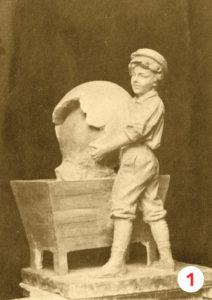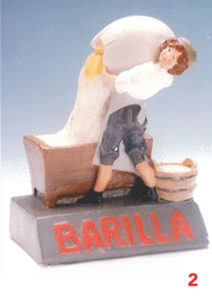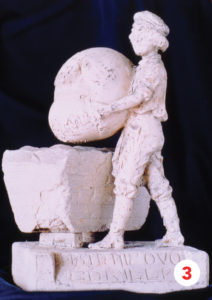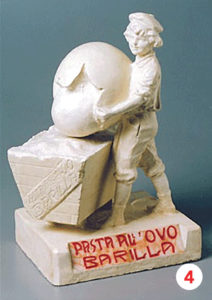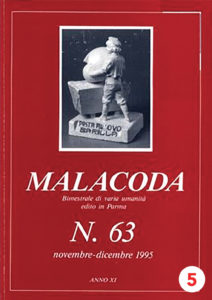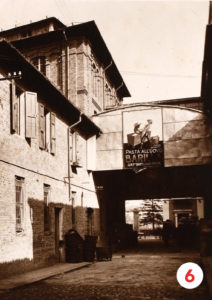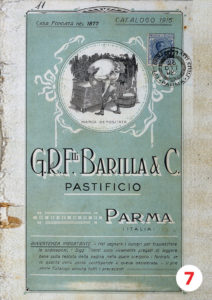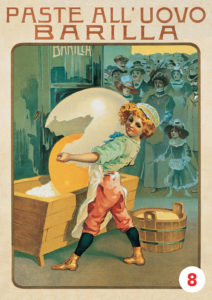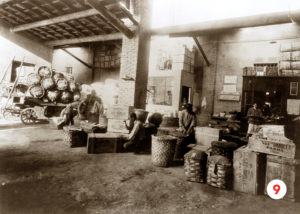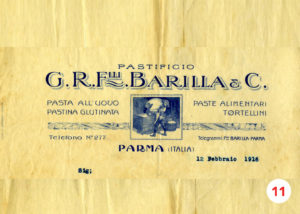The first Barilla logo
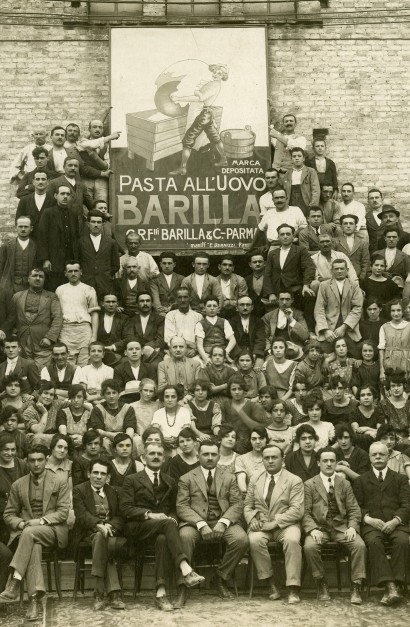
by Giancarlo Gonizzi
Malacoda was a devil. He was the chief of the devils of Malebranche himself, evoked by Dante Alighieri and described in the XXI Canto of the Divine Comedy. However, in Parma, “Malacoda” was a “bimonthly magazine about a variety of humanity” directed by Gian Carlo Mezzadri (1938-2002), and published starting from May 1985.
When – it was the summer of 1994 – in a paper box coming from an internal office, I found number 24 of May-June 1989, I flipped through the pages to understand how come this was there. The index came to my rescue: Caterina Bolondi had written a short essay on “the magic of Barilla advertising” (pages 57-58) where she reviewed in short the evolution of graphic style and communication of the company through the course of the 1900s.
Line after line, well-known stories unfolded, when – there it was – the devil played his dirty trick! I turned a page and found a photo that reproduced the unmistakable image of the shop boy (photo 1) pouring an egg into the trough, the logo of Barilla in the 1910s.
The caption ascribed it to the Parma sculptor Emilio Trombara (1875-1934), today largely forgotten, but very popular in his times to the catholic middle class commissioners for the large number of commemorative works in the city. His works had an unmistakable floral taste, can be found at the Monumental Cemetery, and were known to Gualtiero Barilla (1881-1919) in the first years of the century.
– But then, did he make that?!? No one, up to that moment, had been able to identify the author! But… it was different! I ran to take the scagliola stone polychrome statue (photo 2) from the case of the Historical Archives and placed it on the desk. It reflected on the printed pages. It was different! The subject was identical, but the pose and the dimensions were different. The devil! I quickly retrieved the photographic albums. Photos were still rare, in that era, and there were few pages to glance through: I stopped at the fourth one. The large covered courtyard of the Barilla plant of Viale Veneto in 1913, with the shipment department (photo 9). Men were intent in loading crates and baskets on carts… And there, above, on a mezzanine, there was a sculpture that was identical to that published in the magazine. The devil! We had never seen the original statue.
I looked for professor Mezzadri and asked him where that image came from. An extraordinary story emerged. After a few days, thanks to the clever workings of Mezzadri, I was at the home of Mrs. Teresa Trombara, the daughter-in-law of the sculptor. The ample apartment was located on the last floor where, years earlier, the iron casting and sculpture laboratory of Emilio used to be, at the corner of Piazzale Goito. Now the models, sketches and statues ornate the spaces and surround the apartment, creating a border on the vast terrace of the attic. We opened the albums and the photographs emerged: we could reproduce it. But perhaps there was more… on the terrace. Forgotten in a corner and a bit bruised by bad weather, the statue of the shop boy (photo 3) was still kneading!
The Lady was willing to donate it to the Barilla Historical Archives, on the condition that the figure of her father-in-law was commemorated and his by now forgotten artistic production was revaluated. Albino Ivardi Ganapini, keyperson for the secretary of the presidency of the company, approved with enthusiasm: a monographic issue (photo 5) of “Malacoda” would be dedicated to Emilio Trombara, the statue was restored (photo 4) and from under grayish and fake varnishes, the original straw yellow with the red letters emerged from oblivion. So, Barilla miraculously found anew the author of its first logo and a date for it as well: June 17, 1910. Research at the Central Archives of State made it possible to retrieve the original deposit of the patent.
Later, Parma decorator Ettore Vernizzi (1880-1965), in a panel of large dimensions (photo 6), reproduced the image placed in the entrance of the plant.
The subject enjoyed large fortune and was reprinted on the society’s letterhead (photo 11), on catalogs (photo 7), on pasta crate seals (photo 10), on the advertising poster (photo 8) illustrated in 1911 by Tuscany designer Vincenzo Ceccanti (1871-1916), and remained in use until the 1930s. That photo, that statue, opened the lid ajar on a forgotten world and gave it new life.
When the devil sticks his Mala-coda tail into things…
¹Giancarlo Gonizzi, Alle origini di una azienda: Emilio Trombara, Gualtiero Barilla e il primo marchio della Barilla, in “Malacoda” 1995, n. 63, pp. 3-12; Gianni Capelli, Emilio Trombara, uno scultore da riscoprire, in “Malacoda” 1995, n. 63, pp. 13-21.
